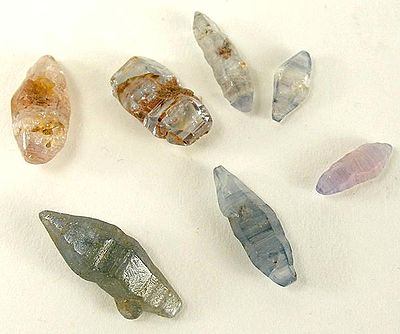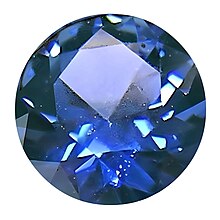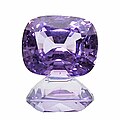sapphire
| sapphire | |
|---|---|
| Different colored raw sapphires from Ratnapura, Sri Lanka | |
| General and classification | |
| other names |
Safir |
| chemical formula | Al 2 O 3 |
|
Mineral class (and possibly department) |
see corundum |
| Similar minerals | Cordierite , benitoite , kyanite , indigolite (mineral of the tourmaline group ), spinel , tanzanite , topaz , zircon |
| Crystallographic Data | |
| Crystal system | trigonal |
| Crystal class ; symbol | ditrigonal-scalenohedral; 3 2 / m |
| Physical Properties | |
| Mohs hardness | 9 |
| Density (g / cm 3 ) | 3.95 to 4.03 |
| Cleavage | no |
| Break ; Tenacity | shell-like, splintery, brittle |
| colour | blue; in the broadest sense all colors except red |
| Line color | White |
| transparency | transparent to opaque |
| shine | Glass gloss |
| Crystal optics | |
| Refractive indices |
n ω = 1.767 to 1.772 n ε = 1.759 to 1.763 |
| Birefringence | δ = 0.008 to 0.009 |
| Optical character | uniaxial negative |
| Pleochroism | only orange-colored sapphire star (yellow-brown-orange to colorless), other colors weak to clear |
| Other properties | |
| Chemical behavior | acid insoluble |
Sapphire , even Safir , is a variety of the mineral corundum . All colorless and brightly colored varieties with the exception of red ruby are assigned to the sapphire . In a narrower sense, the term today refers to the blue variants, which range from sky blue to dark blue that goes into black and can vary in color depending on the incidence of light.
etymology
The word sapphire (to the 13th century term for blue gemstones , especially for lapis lazuli ) Can be widely traced: late latin sapphirus , Latin sappirus , ancient Greek σάπφειρος sappheiros , probably of Aramaic sampîr (Aramaic Saphira =, the Beautiful ') or hebrew סַפִּיר sappir and with arabic صفير, DMG ṣafīr is related. Some linguists suggest further derivation: Old Iranian sani-prijam and Sanskrit शनिप्रिय shanipriya - composed of शनि Shani “ Saturn ” and प्रिय priya “loved” - meaning “loved / adored by Saturn”.
The following trade names are misleading and outdated: oriental aquamarine (greenish blue sapphire), oriental hyacinth (pink sapphire), oriental emerald (green sapphire) and oriental topaz (yellow sapphire).
properties
Like all corundum, sapphire also crystallizes in the trigonal crystal system with the chemical composition Al 2 O 3 and develops predominantly double-sided, barrel-shaped, six-sided pyramidal and prismatic crystals . Chemical resistance is also typical of corundum. For example, sapphire is acid-insoluble and only melts at a temperature of 2050 ° C.
At 25 ° C the thermal conductivity is 41.9 W / (m · K) and the heat capacity is 754 J / (kg · K). This thermal conductivity, which is comparatively high for insulating materials , increases sharply at lower temperatures and decreases at higher temperatures - at 1200 ° C to a tenth of the value at room temperature.
Color and optical effects
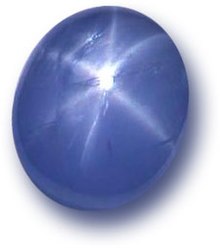
As substances that contribute to the coloring, sapphires contain small admixtures of Fe 2+ and Ti 4+ or Co 2+ (blue), Fe 3+ (yellow and green), Cr 3+ (depending on the concentration red (by definition a ruby) ) to pink), Ti 3+ (pink) and / or V 4+ (purple, together with chrome and iron orange). The colorless leuco sapphire , on the other hand, does not contain any additives.
The classic gemstone sapphire is an intense, but not too dark blue (" Kashmir sapphire "). Sapphires found in the Yogo Gulch canyon in Montana are predominantly deep blue. A specialty among the gemstone sapphires is the so-called Padparadscha , which comes mainly from Asia , a pink to orange-colored variant, the name of which is derived from the Sinhala word for lotus blossom . Padparadschas originally come from Sri Lanka , but are now often color treated and can then come from all over the world.
The star sapphires awarded with the optical effect asterism are also in great demand . Due to the oriented embedded rutile needles , a more or less perfect, six-ray star-shaped reflection is evident .
Education and Locations
For the educational conditions, see Korund # Bildung und Fundorte .
Until recently, the most important producers of sapphires were Sri Lanka and India ; today the gemstones also come from the USA , especially Montana, where sapphires are found in Yogo Gulch, Australia and Nigeria . Sapphires from Madagascar , more precisely Ilakaka , are considered to be of very high quality, but are usually declared as coming from Sri Lanka because they achieve higher prices. The production in Australia has decreased significantly in recent years.
The world's largest sapphire found so far, the so-called "Star of Adam", weighs 1404 carats and was discovered in Sri Lanka. Its value is estimated at around 90 million euros.
Synthetic production and chemical-technical treatment
As early as the Middle Ages there were attempts to artificially manufacture or imitate the "Sapphir stone".
Synthetic sapphires have been manufactured in perfect quality, different colors and in almost unlimited sizes since 1910. For example, the now outdated trade name “Amaryl” denotes a synthetic, light green sapphire. Colorless, synthetic sapphires are sometimes marketed under the misleading trade name “Diamandite” or “Diamondite” and are used as diamond imitations.
Most of the sapphires that are commercially available as “natural” are heat-treated, with the heat treatment being used both to change the color and to increase the clarity of a sapphire. With light heat treatment, microscopic structures such as rutile needles (“silk”) are retained; when heated to a high temperature (approx. 1800 ° C) these natural micro-inclusions are dissolved and the sapphire becomes clear. If the sapphire is cooled down again very slowly, the micro-inclusions can form again. In this way, a Ti-rich, synthetic sapphire can be made into a star sapphire (or ruby). Superficial cracks or small bumps are often covered by melting borax and lead crystal glass or by treating them with oil.
Blue sapphires in particular can also be achieved using a diffusion process, the blue layer being only very thin and superficial. Since around 2000, sapphires have often been heated to 1800 ° C together with beryllium powder in order to suppress blue tones. This creates intense yellow to orange sapphires. Well-known suppliers also use treated sapphires, sometimes including the controversial diffusion treatment, but without individual declarations ( e.g. Tiffany & Co. ).
Synthetic, colorless sapphires
Sapphire glass (synonymous with sapphire flow ) describes flat, mostly colorless plates made of synthetic corundum . They are used, among other things, in watchmaking as watch glasses. The name is misleading as sapphire crystal is not a glass . Sapphire crystal has a crystalline and not a glass-like ( amorphous ) structure. With a Mohs hardness of 9, sapphire is the third hardest of all transparent materials after moissanite and diamond and is therefore particularly valued in this application because of its scratch resistance. Sapphire crystal is high-purity, synthetic sapphire (single crystal), which is made from molten aluminum oxide. The chemical formula is Al 2 O 3 .
Sapphire glass is somewhat less sensitive to impact than conventional quartz glass or mineral glass and has a very high level of light transmission and refraction . However, even sapphire crystal breaks sharp, hard objects under strong pressure. The popular opinion that sapphire glasses are absolutely unscratchable is exaggerated: If other very hard materials (e.g. granite ) and strong pressure (e.g. impact) act on the sapphire crystal, fine scratches can also occur here , but very rarely occurs. The abrasion of aluminum, which is incorrectly referred to as “scratches”, can often be observed when it hits aluminum surfaces. These abrasions provide a durable material bond, but can be easily removed with an eraser .
Physical Properties of Synthetic Sapphire Crystal:
- hexagonal crystal structure
- Density : approx. 4 g / cm³
- Melting point : +2050 ° C
- Thermal conductivity at 25 ° C: 42 W / (m K)
- Compressive strength at 24 ° C: 2 GPa
- Tensile strength at 24 ° C: 186.4 MPa
- 100% acid resistance
With the help of an electronic diamond testing device , as it is used for the reliable determination of naturally cut diamonds in the jewelry industry, you can reliably differentiate sapphire glass from ordinary glass due to its significantly higher thermal conductivity.
There are various manufacturing processes from the melt (in addition to other, technically not important processes from the flux (metal salt melt) or hydrothermal):
- the crucible-free Verneuil process (invented by the French chemist Auguste Verneuil in 1902)
- the EFG method (from English Edge-defined Film-fed Growth ), actually the Stepanov method for the production of sapphire profiles (plates, tubes, rods etc.) with constant cross-section.
- the Czochralski process , invented by the Polish scientist Jan Czochralski in 1916
- the Nacken Kyropoulos procedure , named after Richard Nacken and Spyro Kyropoulos ( Physikalisches Institut Göttingen , 1926).
In the Verneuil process, aluminum oxide powder is melted onto a small piece of sapphire in a chamber at temperatures above 2050 ° C using an oxyhydrogen flame , so that it grows into a crystal pear 3 to 4 cm in diameter and 11 to 14 cm in length. This sapphire crystal is cut into slices using diamond cutting discs, which are then ground and polished until transparent sapphire crystal discs with a shiny surface are created. Depending on the customer's specifications, the panes are also given a polished bevel . The knowledge of the efficient production of high-quality sapphire glasses and in particular the production of the machines and equipment required for this purpose has long been a closely guarded trade secret.
Since sapphire crystal is extremely scratch-resistant due to its high hardness, it is often used in high-quality watches, but watches with sapphire glasses can also be found on the market for less than 60 euros. For a few particularly high-quality Swiss -made watch brands , the entire watch case is made of sapphire. Furthermore, there are even series-produced mechanical movements , the entire plates of which are made of sapphire crystal to give insight into the interior of the mechanics. A very small number of manufacturers and processors of synthetic sapphire glass dominate the global market, especially due to its complex processing in particularly complex shapes. Manufacturers are based in France , Switzerland, Poland and China / Hong Kong , Mauritius and Japan .
Special coatings are common for high-quality sapphire watch glasses, such as B. for anti-reflective coating to reduce light reflection. In the past, some manufacturers used to have a bluish sheen. Manufactured before 2000, these anti-reflective coatings are usually not sufficiently scratch-resistant. In recent times, however, these coatings can usually no longer be removed or rubbed off, and the recognizability of such a coating is usually only given by the effect that the viewer can no longer see any crystal. This feature is particularly pronounced in sapphire glasses with an anti-reflective coating on both sides; the viewer thinks he is looking at a clock without a glass. With a simple test, sapphire glass can be distinguished from other watch glasses. Thanks to the crystalline structure, a drop of water only rolls off the surface very slowly and without streaking when the sapphire crystal is held at an angle. In a direct comparison, the drop runs down visibly faster on mineral glass or plastic glass and leaves a thin streak.
Some manufacturers' high-priced cell phones have a cover glass made of sapphire glass. The cover glass of the liquid crystal display usually consists of special cover glass for displays (e.g. Gorilla Glass ). Sapphire glass can also be used as a scratch-resistant camera lens cover in smartphones .
Use as a gem stone
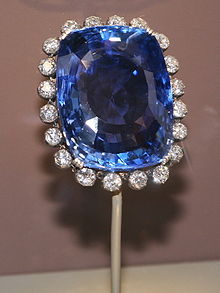
Sapphires are mainly processed into gemstones . Transparent stones of high quality (as few inclusions as possible) are given a facet cut , opaque and especially those with asterism , on the other hand, are made into cabochons to emphasize the star effect.
The largest sapphire ever cut is the “Star of India” with a weight of 563.35 carats (112.67 grams). The stone found in Sri Lanka , about 2 billion years old, was donated to the American Museum of Natural History in 1901 by John Pierpont Morgan and can be viewed there.
Yellow sapphire, navette or marquise, 6.87 ct
Other uses
In addition to its use as a gemstone , sapphire was used in turntables of the 1950s and 1960s as a material for the pick-up stylus, which led to the colloquial name sapphire for this stylus.
Because of its high hardness and abrasion resistance, sapphire is also used as a guide u. a. used for wire EDM and textile machines. Compared to the more solid diamond , it offers considerable cost advantages despite its shorter service life.
Synthetic single-crystal sapphire discs are the most important substrate material for the artificial growth ( heteroepitaxy ) of single-crystal gallium nitride , the material for blue, white and green light-emitting diodes and blue laser diodes .
Doped with titanium as an active laser ion, synthetic sapphire serves as the host crystal for titanium: sapphire laser - a laser that works in the wavelength range from 700 to around 1000 nanometers .
Synthetic sapphires with a diameter of up to 75 centimeters are used for the windows of reconnaissance aircraft, anti-aircraft missiles or spacecraft that are exposed to extreme loads.
In special cases, sapphire is also used in scientific instruments in space travel, for example in the Genesis mission .
Because of its high thermal conductivity of 40 W / (m · K) at a temperature of 25 ° C compared to other insulating materials, discs made of this material are used in scientific experiments, for example when effective cooling or precise temperature control is required the observation must be made through transparent medium. With increasing temperature, however, the thermal conductivity decreases and at 400 ° C is still 12 W / (m · K) and at 1200 ° C only 4 W / (m · K). Lowering the temperature, on the other hand, causes a sharp increase in thermal conductivity, which reaches a value of 10,000 W / (mK) at a temperature of −200 ° C, making the sapphire very suitable for low-temperature experiments.
In the so-called silicon-on-sapphire technology, integrated circuits are produced using heteroepitaxial silicon layers on sapphire .
Esoteric and monastic medicine
The sky blue variant is commonly associated with qualities such as calm, purity, and peace. There is no scientific evidence for the alleged physical or psychological effects. The sapphire was also mentioned in works of medieval medicine.
See also
literature
- Matthias Bodenhöfer: Ilakaka - the capital of the sapphire. A political-ecological study of sapphire mining in Madagascar. Scientific work. Albert Ludwig University, Freiburg i. Br. 2004 ( freidok.uni-freiburg.de full text).
- Petr Korbel, Milan Novák: Mineral Encyclopedia (= Villager Nature ). Nebel Verlag, Eggolsheim 2002, ISBN 978-3-89555-076-8 , p. 82 .
- Walter Schumann: Precious stones and gemstones. All kinds and varieties. 1900 unique pieces . 16th revised edition. BLV Verlag, Munich 2014, ISBN 978-3-8354-1171-5 , pp. 102-105 .
Web links
- Mineral Atlas: Sapphire (Wiki)
Individual evidence
- ^ Wilhelm Ganzenmüller : Contributions to the history of technology and alchemy. Weinheim an der Bergstrasse 1956, pp. 169–176.
- ↑ Duden: The dictionary of origin. 3rd edition 2001, keyword sapphire.
- ^ Karl Lokotsch : Etymological dictionary of the European (Germanic, Romanic and Slavic) words of oriental origin . Carl Winter, Heidelberg 1927; 2nd, unchanged edition 1975 (= Indo-European Library , 2), ISBN 3-533-02427-X , p. 145, no. 1830.
- ↑ sapphire . In: Kluge: Etymological dictionary of the German language .
- ↑ Entry on aluminum oxide / corundum. In: Römpp Online . Georg Thieme Verlag, accessed on May 21, 2016.
- ↑ Material properties of synthetic sapphire at oskar-moser.de.
- ↑ Carl Arnold : Repetitorium der Chemie, with special consideration of the compounds important for medicine as well as the "Pharmacopoeia for the German Empire" and other pharmacopoeias. (1st edition 1884), 7th edition Hamburg and Leipzig 1896, p. 213.
- ^ Daniel Lingenhöhl: Minerals: So far the world's largest sapphire excavated. In: Spectrum of Science . January 8, 2016, accessed January 9, 2016 .
- ^ Anton Trutmann: Pharmacopoeia. (Hs. XI. 61 of the Burgerbibliothek Bern). Edition by Rainer Sutterer: Anton Trutmann's 'Pharmacopoeia', Part I: Text. Medical dissertation Bonn 1976, sheet 56 ("Nim urinam [...] in it solvier alun and leig christallum purum in it for 7 days, Darnoch [...] south in lasûr, so hosts a sapphire").
- ↑ PW Hartmann: Amaryl. In: The great art dictionary.
- ↑ Gemstones - syntheses, imitations and false trade names carat-online.at.
- ↑ John L. Emmett, Kenneth Scarratt, Shane F. McClure, Thomas Moses, Troy R. Douthit, Richard Hughes, Steven Novak, James E. Shigley, Wuyi Wang, Owen Bordelon, Robert E. Kane: Beryllium Diffusion of Ruby and Sapphire (PDF; 1.3 MB). In: Gems and Gemology. 2003, pp. 84-135.
- ↑ Johann Georg Krünitz, Friedrich Jakob Floerken, Heinrich Gustav Flörke, Johann Wilhelm David Korth, Carl Otto Hoffmann, Ludwig Kossarski, J. Pauli: Oekonomische encyklopädie. Volume 136, 1824, p. 431.
- ^ Mineral Atlas: Artificial Crystals.
- ↑ finepowder.de ( Memento of the original from August 28, 2013 in the Internet Archive ) Info: The archive link was automatically inserted and not yet checked. Please check the original and archive link according to the instructions and then remove this notice.
- ↑ Everything you need to know about sapphire glass for watches with comparison | vild . In: vild . September 24, 2018 ( vild-shop.com [accessed October 15, 2018]).
- ↑ Press release on the manufacturer's website. apple.com, accessed February 13, 2014.
- ↑ Star of India. amnh.org (English). Accessed January 9, 2014.
- ↑ GWI Sapphire - Properties of Monocrystal Sapphire. (PDF; 31 kB).
- ^ Raimund Struck: Hildegardis De lapidibus ex libro simplicis medicinae: Critical edition comparing other lapidaries. Medical dissertation Marburg 1985, pp. 24-29 and 100.
- ^ Marie-Louise Portmann. Hildegard von Bingen. Healing power of nature - "Physica." Augsburg 1991, pp. 306–309.
